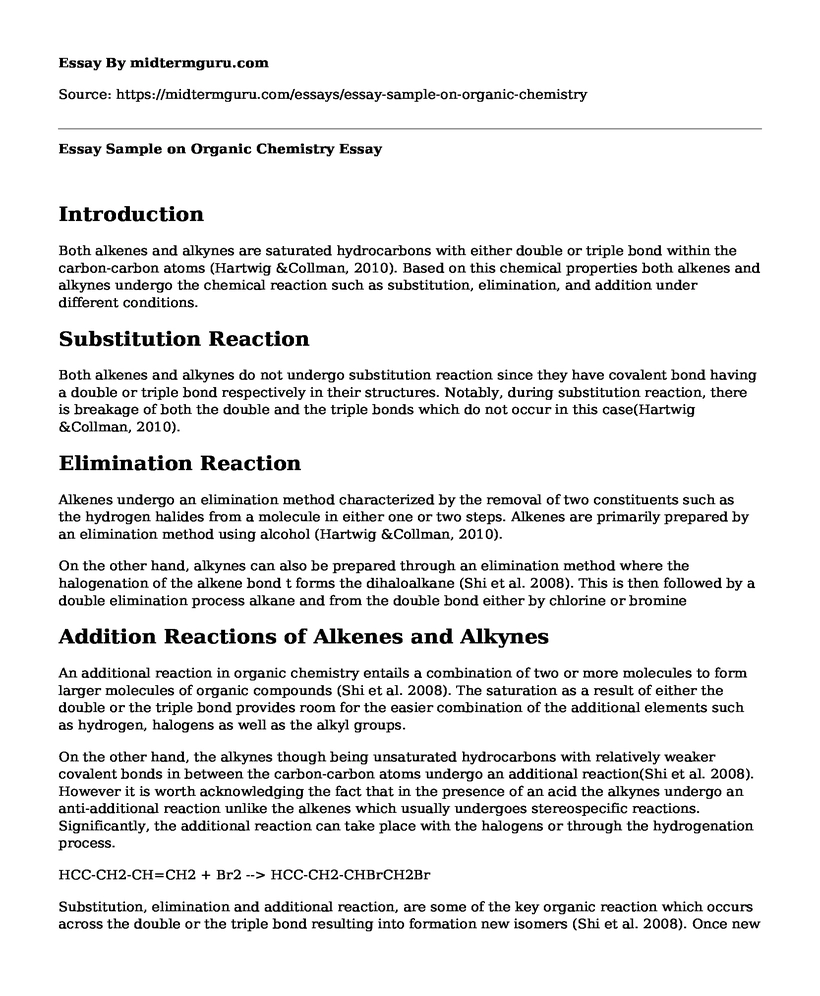Introduction
Both alkenes and alkynes are saturated hydrocarbons with either double or triple bond within the carbon-carbon atoms (Hartwig &Collman, 2010). Based on this chemical properties both alkenes and alkynes undergo the chemical reaction such as substitution, elimination, and addition under different conditions.
Substitution Reaction
Both alkenes and alkynes do not undergo substitution reaction since they have covalent bond having a double or triple bond respectively in their structures. Notably, during substitution reaction, there is breakage of both the double and the triple bonds which do not occur in this case(Hartwig &Collman, 2010).
Elimination Reaction
Alkenes undergo an elimination method characterized by the removal of two constituents such as the hydrogen halides from a molecule in either one or two steps. Alkenes are primarily prepared by an elimination method using alcohol (Hartwig &Collman, 2010).
On the other hand, alkynes can also be prepared through an elimination method where the halogenation of the alkene bond t forms the dihaloalkane (Shi et al. 2008). This is then followed by a double elimination process alkane and from the double bond either by chlorine or bromine
Addition Reactions of Alkenes and Alkynes
An additional reaction in organic chemistry entails a combination of two or more molecules to form larger molecules of organic compounds (Shi et al. 2008). The saturation as a result of either the double or the triple bond provides room for the easier combination of the additional elements such as hydrogen, halogens as well as the alkyl groups.
On the other hand, the alkynes though being unsaturated hydrocarbons with relatively weaker covalent bonds in between the carbon-carbon atoms undergo an additional reaction(Shi et al. 2008). However it is worth acknowledging the fact that in the presence of an acid the alkynes undergo an anti-additional reaction unlike the alkenes which usually undergoes stereospecific reactions. Significantly, the additional reaction can take place with the halogens or through the hydrogenation process.
HCC-CH2-CH=CH2 + Br2 --> HCC-CH2-CHBrCH2Br
Substitution, elimination and additional reaction, are some of the key organic reaction which occurs across the double or the triple bond resulting into formation new isomers (Shi et al. 2008). Once new organic compounds are formed, the entire nomenclature changes like from butyne to 2, 2, di bromobutane during halogenation by bromine water. In addition, certain process such as elimination and additional reactions also plays an important role in the general synthesis of the new products. For example during preparation of alkenes, alcohols are hydrolysed in a two-step mechanism (Shi et al. 2008).
References
Hartwig, J. F., & Collman, J. P. (2010). Organotransition metal chemistry: from bonding to catalysis (pp. 27-32). Sausalito, CA: University Science Books.
Shi, Y., Peterson, S. M., Haberaecker, W. W., & Blum, S. A. (2008). Alkynes as Stille reaction pseudohalides: gold-and palladium-catalyzed synthesis of tri-and tetra-substituted olefins. Journal of the American Chemical Society, 130(7), 2168-2169.
Cite this page
Essay Sample on Organic Chemistry. (2022, Oct 24). Retrieved from https://midtermguru.com/essays/essay-sample-on-organic-chemistry
If you are the original author of this essay and no longer wish to have it published on the midtermguru.com website, please click below to request its removal:
- O-Xylene and ISOMAR Process - Paper Example
- Politics Essay Sample: Political Geography and Theoretical Models
- The Vibrational and Rotational Energy Spectrums of the Molecule HCl - Paper Example
- Essay on Chemical Contamination of Food Substances
- Anthropocentrism: Human-Centric Environmental Responsibility - Essay Sample
- Devonian Period: The Age of Fishes & Ammonites - Research Paper
- Fire Dynamics Case Study







